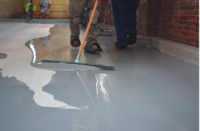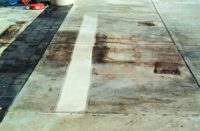MAINTENANCE. This one word has become the driving factor for growth in the decorative concrete industry and at the same time is the most frustrating issue I deal with regularly. I have read many articles that give different opinions about how to maintain polished concrete. What I have not read are articles that approach this issue from the customer’s side.
As a consultant, I spend most of my time managing polished concrete programs for retailers. Both large and small retailers experience similar issues related to maintenance. Let me take you through this issue from a different perspective. My goal here is to broaden your view and perhaps allow you to approach this issue differently.
Sweep, scrub, burnish
The maintenance for polished concrete is simple. Basically, you sweep it regularly, scrub it on a schedule with appropriate cleaners and burnish it a few times a year. This sounds simple, right? In some cases, this works out perfectly. In others, not so much.
What I see in the field, especially with larger retailers, is that most janitorial contracts are outsourced. There are multiple layers of separation between the polished concrete installer and the nightly janitorial work. You remember the game “Telephone” from when you were a kid, where a story starts at one end of a line of people and is retold? It always changes by the time it goes through several people. Maintenance is like that as well.
A polished concrete contractor places the floor and provides the GC with his or her version of maintenance info. The GC shares it with the architect, who shares it with a project manager for the customer/owner. This PM shares it with his or her boss in the construction division who then sits in a meeting and shares it with the operations group. An operations manager shares it with a maintenance manager, who gets it to a regional maintenance PM. This PM then shares it with his or her prime janitorial contractor who then meets with and shares it with the owner of the small janitorial company who is in charge of maintenance at the store. This manager then shares the information with a crew leader who takes care of the store overnight.
If you have not been keeping track, that is 11 degrees of separation between the installer and the person actually taking care of the floor. That is, if the smaller janitorial contractor hasn’t subbed it down one more level. In that case, add two more people to the party. You can imagine how much the requirements change from one end of this string to the other.
Changes add up
I see several common denominators regularly misinterpreted or modified that significantly impact the life of polished concrete floors. First, the soap being used changes. The best cleaners for polished concrete are made by chemical companies in the polished concrete industry. The only issue with this is sometimes these chemicals are harder to find or buy for a janitorial contractor who doesn’t know these industry-specific companies. The chemicals aren’t sold at most janitorial supply houses, so getting the right cleaner is the first obstacle.
What generally happens is that a well-meaning chemical sales representative who services the janitorial contractor doesn’t want to lose any revenue, so he tries to find a compatible cleaner in his arsenal. Sometimes it works, but more often it does not. I can go through project after project where an amazing array of cleaners has been used. I have seen everything from water on one end of the spectrum to a cleaner made up of boric acid and alcohol on the other end.
Good polished concrete cleaners lift the dirt without leaving a residue or etching the surface. The best cleaners have some densifier and stain protection built in. These help the floor get stronger and more stain-resistant over time.
I routinely see projects being etched or have a film buildup on them. These issues are most common when a separate maintenance contractor is doing the work. I believe some of this is caused by janitorial field employees trying to do what they feel is correct, but I also think cost is a factor just as often.
The janitorial contractors are not helped when they move from a VCT floor to a polished concrete floor. The labor hours go down significantly, a lot less chemical is used so they lose their markup on the chemicals, and they lose some of their bulk discounts because they are buying less product. Additionally, the twice-annual strip and wax is gone, so that is a big hit right there.
Consequently, it is better for a janitorial contractor if polished concrete does not become the standard. There is not a lot of incentive to closely follow a maintenance program. Retailers get frustrated by this, but it is something our industry will have to deal with for the time being. These things are important to think about as you are installing a polished concrete floor.
You can help
There are some things contractors can help with. As the project is wrapping up, ask your customer who will be doing the maintenance. For some contractors, this may be a source of ongoing revenue if they can take care of their own floors for the customer. Whoever is doing the actual, daily maintenance work should attend a meeting between that person, you as the flooring installer and your owner.
Walk through the steps needed to take care of the floor. This way at least no one can say you did not pass on the information. Provide a written copy of the maintenance procedures. This is especially important on commercial projects where you have a one-year walk-through. If the floor is maintained poorly, the shine could decrease rapidly.
Many times, this is put back to the contractor who installed the flooring as a statement of poor workmanship. If you can avoid this by simply discussing the issue, you are doing yourself, the customer and the industry a huge favor.
Combat poor maintenance
There are a few things I suggest to combat poor maintenance. First, I help the owner establish a supply link for good-quality, appropriate products. This is imperative. I always recommend owners purchase all chemicals and supply them to their janitorial staff. This takes the opportunity away from the contractor to change products.
Second, I provide very specific written instructions to the GC and the end-user. Third, I show customers how to measure gloss and, based on other projects, give them an average range the polishing will decrease each year as long as the floor is maintained correctly. The customer then can monitor this in-house or regionally.
When the simple process for maintaining floors is followed, the project stays in good shape for a long time. I recently visited a facility where I polished the concrete as a contractor about 12 years ago. Since then, they have followed the original maintenance instructions I gave them. I performed gloss testing and the floor averages a 51 gloss after 12 years of mid to heavy foot traffic. This is better than most projects I have seen, but it is a good demonstration of the benefits of correctly taking care of floors.
Maintenance is an issue that every manufacturer, distributor and installer has to address. The industry needs to get together and provide a solution that’s similar from one manufacturer to the next. Manufacturers need to accept that their regular customers are not the best distributors of janitorial chemicals.
If and/or when these things start to happen, maintenance will no longer be a double-edged sword. Instead, it will become the club by which the polished concrete industry beats back the competition by forcing massive additional growth.
Think about this: Polished concrete is supposed to be a long-lasting flooring solution. If, because of poor maintenance, this proves not to be the case, how long do you think interest in polished concrete will continue?
Installing a polished concrete floor without a good maintenance plan is like building a car without providing maintenance schedules or manuals. Very soon, parts will start to wear out and the car will break down. The polishing industry cannot afford to have breakdowns just as we are building good momentum. Please provide every customer with a good maintenance plan and think about ways to ensure the work is being done correctly.















